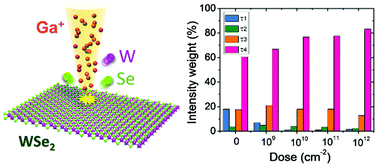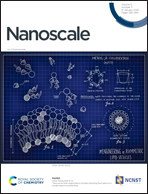Defect creation in WSe2 with a microsecond photoluminescence lifetime by focused ion beam irradiation†
Abstract
Defect engineering is important for tailoring the electronic and optical properties of two-dimensional materials, and the capability of generating defects of certain types at specific locations is meaningful for potential applications such as optoelectronics and quantum photonics. In this work, atomic defects are created in single-layer WSe2 using focused ion beam (FIB) irradiation, with defect densities spanning many orders of magnitude. The influences of defects are systematically characterized. Raman spectroscopy can only discern defects in WSe2 for a FIB dose higher than 1 × 1013 cm−2, which causes blue shifts of both A′1 and E′ modes. Photoluminescence (PL) of WSe2 is more sensitive to defects. At cryogenic temperature, the low-energy PL induced by defects can be revealed, which shows redshifts and broadenings with increased FIB doses. Similar Raman shifts and PL spectrum changes are observed for the WSe2 film grown by chemical vapor deposition (CVD). A four microsecond-long lifetime is observed in the PL dynamics and is three orders of magnitude longer than the often observed delocalized exciton lifetime and becomes more dominant for WSe2 with increasing FIB doses. The ultra-long lifetime of PL in single-layer WSe2 is consistent with first-principles calculation results considering the creation of both chalcogen and metal vacancies by FIB, and can be valuable for photo-catalytic reactions, valleytronics and quantum light emissions owing to the longer carrier separation/manipulation time.



 Please wait while we load your content...
Please wait while we load your content...
